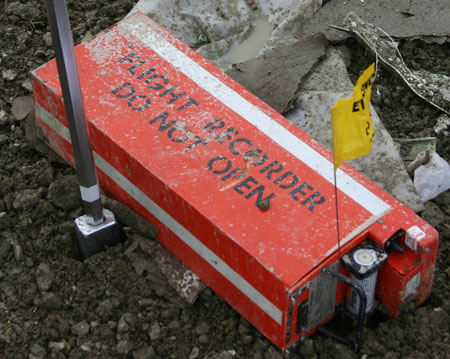In-flight fire leading to collision with water
Swissair Transport Limited
McDonnell Douglas MD-11 HB-IWF
Peggy's Cove, Nova Scotia 5 nm SW
Swissair Transport Limited
McDonnell Douglas MD-11 HB-IWF
Peggy's Cove, Nova Scotia 5 nm SW
The occurrence
On 2 September 1998, Swissair Flight 111 departed New York, United States of America, at 2018 eastern daylight savings time on a scheduled flight to Geneva, Switzerland, with 215 passengers and 14 crew members on board. About 53 minutes after departure, while cruising at flight level 330, the flight crew smelled an abnormal odour in the cockpit. Their attention was then drawn to an unspecified area behind and above them and they began to investigate the source. Whatever they saw initially was shortly thereafter no longer perceived to be visible. They agreed that the origin of the anomaly was the air conditioning system. When they assessed that what they had seen or were now seeing was definitely smoke, they decided to divert. They initially began a turn toward Boston; however, when air traffic services mentioned Halifax, Nova Scotia, as an alternative airport, they changed the destination to the Halifax International Airport. While the flight crew was preparing for the landing in Halifax, they were unaware that a fire was spreading above the ceiling in the front area of the aircraft. About 13 minutes after the abnormal odour was detected, the aircraft's flight data recorder began to record a rapid succession of aircraft systems-related failures. The flight crew declared an emergency and indicated a need to land immediately. About one minute later, radio communications and secondary radar contact with the aircraft were lost, and the flight recorders stopped functioning. About five and one-half minutes later, the aircraft crashed into the ocean about five nautical miles southwest of Peggy's Cove, Nova Scotia, Canada. The aircraft was destroyed and there were no survivors.
Safety communications
Interim air safety recommendations
Flight recorder duration and power supply
Read the Interim air safety recommendation
Thermal acoustical insulation materials
Read the Interim air safety recommendation
In-flight firefighting
Read the Interim air safety recommendation
Material flammability standards
Read the Interim air safety recommendation
Aviation safety advisory
MD-11 wiring (980031-1)
Read the aviation safety advisory
MD-11 flight crew reading light (map light) installations (A000008-1)
Read the aviation safety advisory
Controller knowledge of flight crew emergency procedures (A010020-1)
Read the aviation safety advisory
MD-11 standby (secondary) instruments (A010042-1)
Read the aviation safety advisory
MD-11 standby (secondary) instruments (A010042-2)
Read the aviation safety advisory
Aviation safety information letter
Flight crew reading light (A000061-1)
Read the aviation safety information letter
Overhead aisle and emergency lights – MD–11 (A000062-1)
Read the aviation safety information letter
Overhead aisle and emergency lights – MD–11 (A000062-2)
Read the aviation safety information letter
Safety concerns
In-flight firefighting measures
Read the safety concern
Media materials
News releases
Backgrounders
A98H0003 (Swissair Flight 111): Abbreviated Investigation Chronology
Read the backgrounder
A98H0003 (Swissair Flight 111): Background and Fact Sheet
Read the backgrounder
A98H0003 (Swissair Flight 111): Summary of Safety Action Taken in Response to TSB SR 111 Investigation Safety Communications
Read the backgrounder
A98H0003 (Swissair Flight 111): Executive Summary
Read the backgrounder
A98H0003 (Swissair Flight 111): Aircraft Flight Recorders
Read the backgrounder
Deployment notice
TSB Deploys Team to Investigate Air accident
Gatineau, Quebec, August 20, 2011 - The Transportation Safety Board of Canada has deployed a team
Investigation information
Download high-resolution photos from the TSB Flickr page.
Class of investigation
This is a class 3 investigation. These investigations analyze a small number of safety issues, and may result in recommendations. Class 3 investigations are generally completed within 450 days. For more information, see the Policy on Occurrence Classification.
TSB investigation process
There are 3 phases to a TSB investigation
- Field phase: a team of investigators examines the occurrence site and wreckage, interviews witnesses and collects pertinent information.
- Examination and analysis phase: the TSB reviews pertinent records, tests components of the wreckage in the lab, determines the sequence of events and identifies safety deficiencies. When safety deficiencies are suspected or confirmed, the TSB advises the appropriate authority without waiting until publication of the final report.
- Report phase: a confidential draft report is approved by the Board and sent to persons and corporations who are directly concerned by the report. They then have the opportunity to dispute or correct information they believe to be incorrect. The Board considers all representations before approving the final report, which is subsequently released to the public.
For more information, see our Investigation process page.
The TSB is an independent agency that investigates air, marine, pipeline, and rail transportation occurrences. Its sole aim is the advancement of transportation safety. It is not the function of the Board to assign fault or determine civil or criminal liability.
